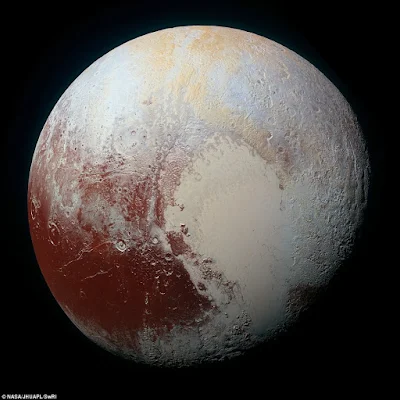Τα εντυπωσιακά Τάρταρα του Πλούτωνα που σε κάποιους θυμίζουν ένα φίδι. Ιn this
extended color image of Pluto taken by NASA's New Horizons spacecraft, rounded
and bizarrely textured mountains, informally named the Tartarus Dorsa, rise up
along Pluto's day-night terminator and show intricate but puzzling patterns of
blue-gray ridges and reddish material in between. This view, roughly 330 miles
(530 kilometers) across, combines blue, red and infrared images taken by the
Ralph/Multispectral Visual Imaging Camera (MVIC) on July 14, 2015, and resolves
details and colors on scales as small as 0.8 miles (1.3 kilometers). Credit:
NASA/Johns Hopkins University Applied Physics Laboratory/Southwest Research
Institute
Πιστή
στο ραντεβού της Παρασκευής η NASA
δημοσίευσε νέες εικόνες από τον πλανήτη νάνο του ηλιακού μας συστήματος.
New Horizons
captured this high-resolution enhanced colour view of Pluto on July 14. The
dwarf planet's surface sports a remarkable range of subtle colours, enhanced in
this view to a rainbow of pale blues, yellows, oranges, and deep reds. Many
landforms have their own distinct colours, telling a complex geological and
climatological story that scientists have only just begun to decode.
This cylindrical
projection map of Pluto, in enhanced, extended color, is the most detailed
color map of Pluto ever made. It uses recently returned color imagery from the
New Horizons Ralph camera, which is draped onto a base map of images from the
NASA's spacecraft's Long Range Reconnaissance Imager (LORRI). The map can be
zoomed in to reveal exquisite detail with high scientific value. Color
variations have been enhanced to bring out subtle differences. Colors used in
this map are the blue, red, and near-infrared filter channels of the Ralph
instrument. Credit: NASA/Johns Hopkins University Applied Physics
Laboratory/Southwest Research Institute
High-resolution
images of Pluto taken by NASA's New Horizons spacecraft just before closest
approach on July 14, 2015, reveal features as small as 270 yards (250 meters)
across, from craters to faulted mountain blocks, to the textured surface of the
vast basin informally called Sputnik Planum. Enhanced color has been added from
the global color image. This image is about 330 miles (530 kilometers) across. Credit:
NASA/Johns Hopkins University Applied Physics Laboratory/Southwest Research
Institute
Πρόκειται
για τις υψηλότερης ανάλυσης εικόνες που έχουμε δει από τον Πλούτωνα μέχρι
σήμερα. Η πιο εντυπωσιακή εξ αυτών δείχνει με λεπτομέρεια μια περιοχή με
παράλληλες ευθυγραμμισμένες οροσειρές οι οποίες ονομάστηκαν Τάρταρα! Τα στελέχη
της αποστολής New
Horizons αναφέρουν στην
ανακοίνωση για τις νέες εικόνες που έδωσαν στη δημοσιότητα ότι Τάρταρα μοιάζουν
πολύ με… δέρμα φιδιού.




